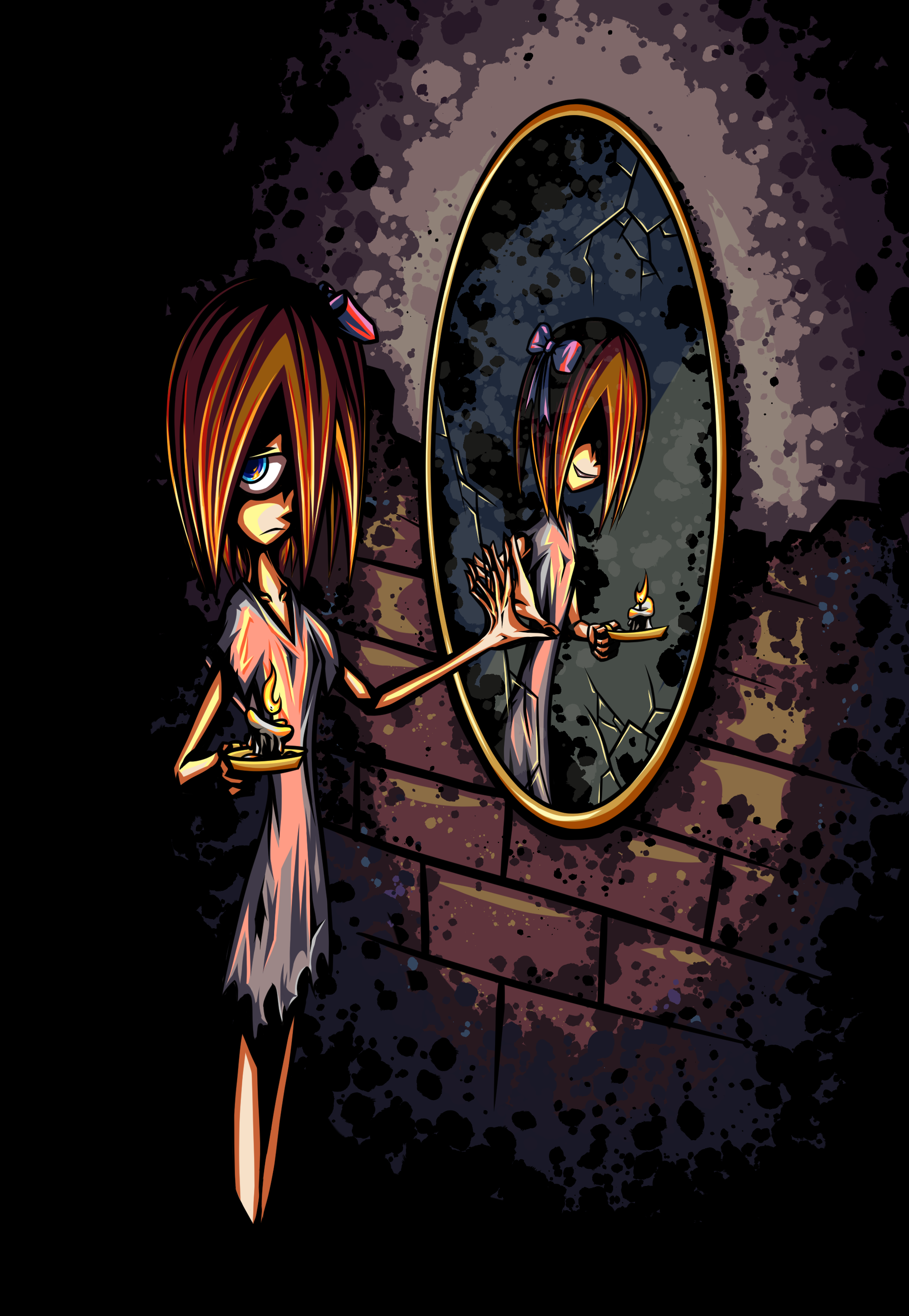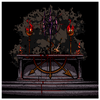
It is generally accepted by historians that Godwin Piedmont started the Night of the Fire. Though there isn’t much in the form of hard evidence, Godwin’s known personal history and the factory’s papertrail strongly suggests an act of truly horrifying insurance fraud. Separated from the outside, this accusation is not universally accepted by the victims themselves. To clarify, most of the kids in Piedmont actually do believe it was Godwin, just not all of them. It should be unsurprising that Billy wants a villainous adult to direct his hate towards and even Eugene, who had a chance to look through Piedmont’s papers is also generally convinced it was the former caretaker who murdered them. Very few kids believe it might’ve been a legitimate accident. However, there is another conspiracy that has been allowed to fester in those walls for the last 70 years. That it was Sarah Madeline who started the fire.
The notion seems absurd. Sarah was a giver in life, constantly doing things for others, even at great sacrifice to herself. Even in death, though the madness has stripped her of her compassion, she has still dedicated her eternal existence to maintaining the factory for the better of everyone in it. Yet there have been many factors that make the candle girl seem suspicious.
Sarah came to Piedmont at the age of 5 after a mysterious fire took the lives of her parents. At the time she was mortified, seemingly having lost the will to live but it did not take long for her to find purpose in putting others before herself. The connection to fire here is an obvious one. Though her past is tragic, Piedmont was an environment where everyone had lost their parents, it was not unique. There are many even amongst her peers who had thought her reaction to her loss was an unusual one. A conniving boy named Franklin was the first to say it out loud. That she was acting out of guilt, accusing her of killing her parents. To everyone’s absolute shock, this culminated in a fight where mild mannered Sarah, in a fit of truly unprecedented rage, grabbed the boy and burned half his face with a blowtorch, once again the connection to fire difficult to ignore. Noone in Piedmont liked creepy little Franklin and many outright sided with Sarah, saying he deserved it; but the event did raise alarms in the minds of many. A handful of kids would never fully trust Sarah again after that.
The particular situation was just the beginning for after that encounter more and more instances of Sarah acting strangely began to arise. She seemed to always have a box of matches on her, lit more candles than seemed necessary, and had odd bouts where she acted unlike herself. A few kids proclaimed she had a strange look to her when playing with fire, staring at the flame with just a small smirk. Whenever brought up, she denied everything claiming she had no memory of such things.
Even after her death, the fact that her ghost is almost always seen with a small flame is noteworthy, the outside world even knows her as “the Candle Girl.” The most terrifying piece of evidence is her haunts, the few times when she kills. Most ghosts in Piedmont have an understandable fear of fire. Some intruders find this out and use a torch to shield them from the murderous spirits. To Sarah it triggers the opposite response. Her eyes grow wide with wonder at the sight of the violent flames, a maniacal smile screens across her entire face. The torch explodes causing whoever was holding it to catch aflame and before consuming the entire room, reenacting the night of the fire. Sarah laughs as she watches the intruder be burned alive before being consumed by the inferno herself.
But to her friends, the most damning evidence of all is Sarah herself for she has never denied the accusation and has always merely moved the conversation elsewhere. This is because Sarah herself understands how the evidence looks and it terrifies her. The truth is that Sarah knows she killed her parents, unintentional though it might have been. She has indeed been living a self-flagellating life as a form of penance for her sins. Even before her fight with Franklin, she knew she was losing control of herself. Years of neglecting her own desires was fracturing her personality, creating an entity that she referred to as the other Sarah, whom she has desperately tried to control.
All this has made her doubt herself entirely. Other Sarah, to her defense, has adamantly denied starting the Night of the Fire. Sarah herself, refuses to converse any further on this topic, ever. If she found any reason to believe she might’ve been responsible for the Night of the Fire, that she was the one who killed all her friends… well that might just break her.
The notion seems absurd. Sarah was a giver in life, constantly doing things for others, even at great sacrifice to herself. Even in death, though the madness has stripped her of her compassion, she has still dedicated her eternal existence to maintaining the factory for the better of everyone in it. Yet there have been many factors that make the candle girl seem suspicious.
Sarah came to Piedmont at the age of 5 after a mysterious fire took the lives of her parents. At the time she was mortified, seemingly having lost the will to live but it did not take long for her to find purpose in putting others before herself. The connection to fire here is an obvious one. Though her past is tragic, Piedmont was an environment where everyone had lost their parents, it was not unique. There are many even amongst her peers who had thought her reaction to her loss was an unusual one. A conniving boy named Franklin was the first to say it out loud. That she was acting out of guilt, accusing her of killing her parents. To everyone’s absolute shock, this culminated in a fight where mild mannered Sarah, in a fit of truly unprecedented rage, grabbed the boy and burned half his face with a blowtorch, once again the connection to fire difficult to ignore. Noone in Piedmont liked creepy little Franklin and many outright sided with Sarah, saying he deserved it; but the event did raise alarms in the minds of many. A handful of kids would never fully trust Sarah again after that.
The particular situation was just the beginning for after that encounter more and more instances of Sarah acting strangely began to arise. She seemed to always have a box of matches on her, lit more candles than seemed necessary, and had odd bouts where she acted unlike herself. A few kids proclaimed she had a strange look to her when playing with fire, staring at the flame with just a small smirk. Whenever brought up, she denied everything claiming she had no memory of such things.
Even after her death, the fact that her ghost is almost always seen with a small flame is noteworthy, the outside world even knows her as “the Candle Girl.” The most terrifying piece of evidence is her haunts, the few times when she kills. Most ghosts in Piedmont have an understandable fear of fire. Some intruders find this out and use a torch to shield them from the murderous spirits. To Sarah it triggers the opposite response. Her eyes grow wide with wonder at the sight of the violent flames, a maniacal smile screens across her entire face. The torch explodes causing whoever was holding it to catch aflame and before consuming the entire room, reenacting the night of the fire. Sarah laughs as she watches the intruder be burned alive before being consumed by the inferno herself.
But to her friends, the most damning evidence of all is Sarah herself for she has never denied the accusation and has always merely moved the conversation elsewhere. This is because Sarah herself understands how the evidence looks and it terrifies her. The truth is that Sarah knows she killed her parents, unintentional though it might have been. She has indeed been living a self-flagellating life as a form of penance for her sins. Even before her fight with Franklin, she knew she was losing control of herself. Years of neglecting her own desires was fracturing her personality, creating an entity that she referred to as the other Sarah, whom she has desperately tried to control.
All this has made her doubt herself entirely. Other Sarah, to her defense, has adamantly denied starting the Night of the Fire. Sarah herself, refuses to converse any further on this topic, ever. If she found any reason to believe she might’ve been responsible for the Night of the Fire, that she was the one who killed all her friends… well that might just break her.
Life After Death: A Burning Conspiracy by @rollee (Rollee Bitterblossom)
When most people think of ghosts they imagine white sheet ragged specters that can fly through walls. The ghosts of Piedmont aren’t exactly like this. While active, they can be indistinguishable from a living person; drabber in color and cold to the touch but, at least at first glance, easy to mistake as just a particularly dirty or unhealthy child. For the most part the restraints of the physical world still loosely apply to them. These kids still have lives in all but the most literal sense.
If you liked this story and found the Factory of Madness interesting I have a group where I store the art and stories. Here
The image for the cover art can be found here
Category:
Rating:
Teen ()
Class:
Finished Work
Submitted:
1y45d ago
Tags:



"might just break her"? I would have to guess that finding out would completely erase the nice Sarah and let the pyro become the permanent personality. Interesting piece, and yet more evidence that none of these kids met death unscathed.